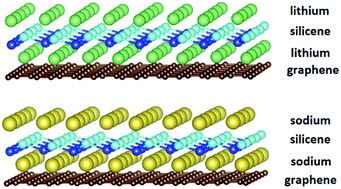Ab initio prediction of a silicene and graphene heterostructure as an anode material for Li- and Na-ion batteries†
Abstract
Silicene has been predicted to be an extraordinary anode material for lithium-ion batteries with a large capacity and low lithium migration energy barriers, but the free-standing form of silicene is unstable, virtually requiring a substrate support. In this work, we propose to use graphene as a substrate and a protective layer of silicene, forming a van der Waals heterostructure of silicene and graphene (Si/G) to serve as a prospective anode material for lithium/sodium-ion batteries. Ab initio calculations show that the Si/G heterostructure not only preserves the silicene's large lithium/sodium capacity (487 mA h g−1) and low lithium/sodium migration energy barriers (<0.4 eV for lithium and <0.3 eV for sodium), but also provides much larger lithium/sodium binding energies via a synergistic effect, which can effectively inhibit the formation of dendrites. Density of states results show that the Si/G heterostructure is metallic before and after lithium/sodium intercalation, ensuring a good electronic conductivity. In addition, the mechanical stiffness of the Si/G heterostructure is found to be larger than that of pristine silicene or graphene, which helps preserve the structural integrity and enhance the cycle performance.



 Please wait while we load your content...
Please wait while we load your content...